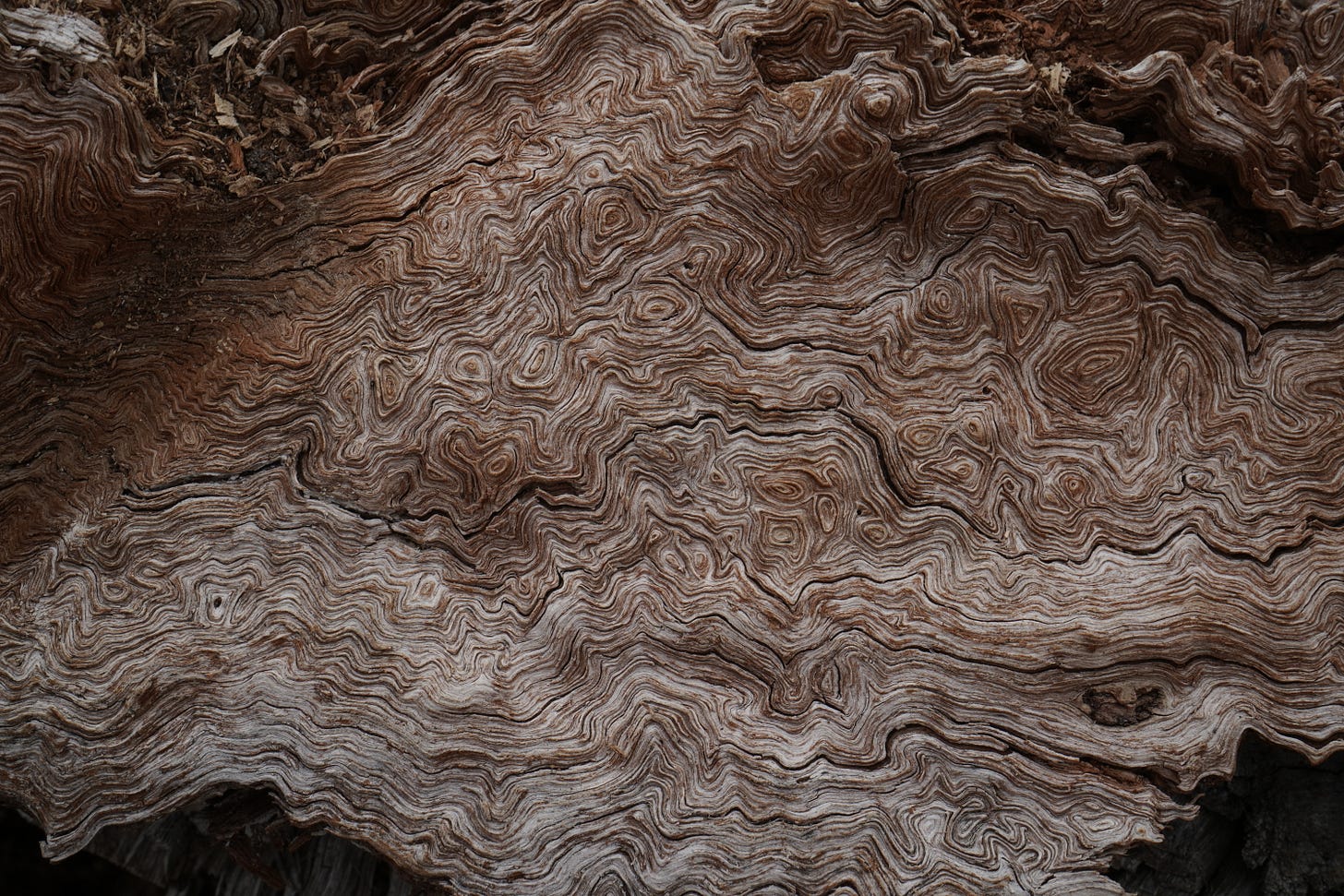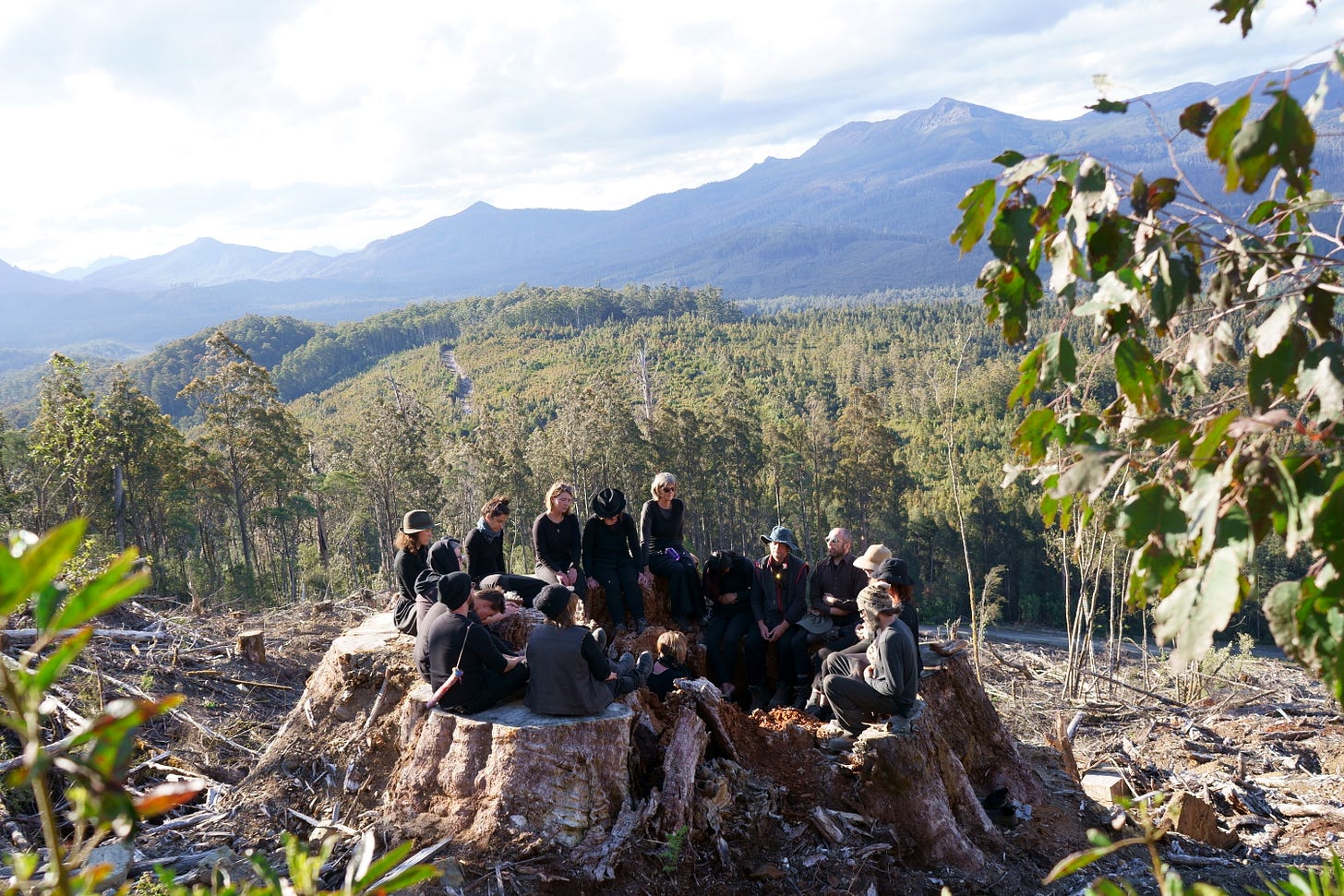
Sitting in a time capsule that should not have been opened. It’s too late now. Pages and shards of inscriptions, at least 500 years old. Pre-colonial stories now exposed to the light, to the weather. They were already decaying, making earth of themselves. Feeding their stories back into the ground, inside the dark of the hollow core. Ancient time now a space, where the young tree once grew. Sprouting from a seed in the 1500s or thereabouts, some 270 years before colonising ships set sail for this land. When possum skins kept palawa and pakana peoples warm and the temperate rainforests of lutruwita Tasmania were free. Free, as in a community of wild sentient beings. Before the guns and saws and hungry ghosts arrived, who recon still that these forests are free for the taking.
Sitting in this wood musky hollow, encircled by what was a few weeks ago living. I hold a tablet in my hands and trace its ancient glyphs with my fingers; spiralling, swirling water movements, folding with time and with the gravity of an enormous body that was recently dragged and trucked away. This sentinel stood on the ridge overlooking a whole valley of kin, now razed to the ground. I close my eyes and drop for a moment beneath the surface, beneath the ribbons of bark and tumbled tree ferns, beneath the forest in splinters. Following the movements of roots branching under the hillside, tunnelling and branching, tunnelling and branching. Intersecting with other roots, Sassafras, Myrtle and Musk Daisy Bush. Threading together with mycelial filaments, entangling with roots of other Eucalyptus regnans, now stumps of these tallest flowering trees on earth.
The ground remembers, below the surface the hillside is still woven. All the seeds of the forest still remain. For now. Before the burning begins. On the other side of the logging road you can see the aftermath. Burnt out stumps, earth baked orange from the impact of a fire bomb flung from the sky. Warfare against natural regrowth, against native forests and ancient organic history. War against life itself. A season or two later, seedlings will be planted inside insidious blue netting that will litter the forest and never be picked up. All to keep the pademelons and wallabies from eating the newly planted trees in their decimated home.
Had a human-made thing of this scale and sacredness been demolished against the wishes of most of the population, it would at least make the news. But this news has gotten old, an every day story, despite decades of protests. We are not here to fight this time, we are here to lament. To practice not walking away from the pain of another obliterated landscape. To ask these questions through relational, somatic and sonic artistic practices; Can touch sense the sentience of trees? Does the fallen forest still resonate? How do we practice the rites and rights of nature?
Sitting together on the stump, we are sixteen people with space for more and one behind the camera. We are all connected to this forest in some way, as artists, activists and academics. We've spent a some days together exploring ways of being with and lamenting the loss of this ancient forest. Instead of walking away from the pain, we are leaning into it, learning from it. Listening to the spirit of this place that still sings softly underground. Before coming here we met with Ruth Langford, an Aboriginal community leader, she made song ceremony and invited us to call on our ancestors to come together in support and healing. Since then we've been singing on stumps, carrying the burnt body of a tree in procession, we've been laying on, playing strings and resonating with an instrument we made from a felled tree. We've been in the bordering forest that still stands, nestling into the moss and gussets of root buttresses, watching light dance between tree fern fronds.
Here on this stump, the forest is still holds us in its absence. Here is a poem from this moment written by Katarina Schlunke:
Mmm when we spoke in the trunk in the burnt out heart of the fired stump of a once towering tree when we spoke one at a time, when we were moved, to speak into that hot, cold, burnt bludgeoned space in that space as each spoke the others, we others, would feel those words and murmur mmm.... mmm it is a soft sound the sound of listening listening to the silence catching something beyond while listening to the absence of trees, birds, other life listening to we tiny tinny humans speaking into that silence in the burnt out heart the fired stump of that enormous tree mmm (say aloud, say together) mmm Later, in the hut I could not draw, what I saw out there I drew the comfort of the kettle water bottles, windows And I needed a drink Having carried a body along the track and held the dead on our shoulders I wanted the wake boisterous music, whisky confusing relief and grief for all that listening had led to hearing unbearable sounds mmm mmm (say it loud, say it together) mmm mmm
Styx Lament is a collaborative artistic process led by Julia Adzuki and Patrick Dallard, together with Amy Barrows, Luke John Campbell, Pema Choo, Tresa Briscoe-Hough, Rodrigo Diaz-Icasuriaga, Lisa Flack, Warwick Lloyd Mauger 'daynu', Amalia Patourakis, Clare Pitt, Raku Pitt, Katrina Schlunke, Sue Stack, Sara Wright and Anna Wylie.
Filmed and recorded by Tomas Björkdal in the Styx Valley.
Co-edited by Tomas Björkdal and Julia Adzuki.
Forest lament song by Julia Adzuki
We acknowledge the Tasmanian Aboriginal community as the Traditional Owners and ongoing custodians of lutruwita / Tasmania. We pay respects to palawa and pakana Elders past, present and emerging and acknowledge that sovereignty was never ceded.
Subscribe for fortnightly letters, delivered every new and full moon to your inbox. All posts are free but we warmly welcome you to support the building, growing and flourishing of A R T I S T S in R E S O N A N C E with a paid subscription, comment or like.





Thank you so much for sharing. Very moving, very sad.
Quite lovely. I enjoyed the film. Very sad too.